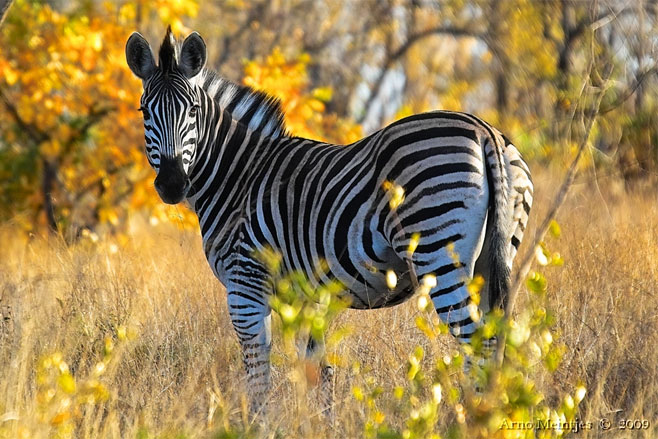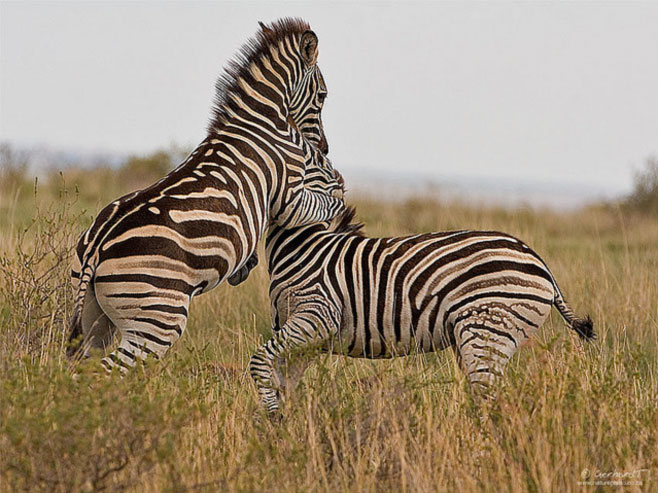|
Equus quagga (Plains zebra, Chapman's zebra, Burchell's zebra)
bontsebra, bontkwagga, Chapman-sebra [Afrikaans]; Steppenzebra [German]; zŤbra de Burchell
[French]; idube, iduba elimibalabala, idube elibhondo [isiNdebele]; iqwarhashe [isiXhosa]; idube [isiZulu]; pitsi [Sepedi]; pite ya naga, pitsi
ya naha [Sesotho]; pitse,
pitse ya naga, pitse yanagÍng, pitse Ítilodi, pitse Ítilotsana, pÍrÍ yanaga sÍbora [Setswana]; lidvubu, lidvuba [siSwati]; mangwa,
mbizi, duva [Xitsonga]; mbidi [Tshivenda]; pizi [Lozi]; umbiyi [Yei]; !Goreb, !Goareb
[Nama, Damara]
Life
>
Eukaryotes >
Opisthokonta >
Metazoa (animals) > Bilateria > Deuterostomia >
Chordata > Craniata > Vertebrata (vertebrates) >
Gnathostomata (jawed vertebrates) > Teleostomi (teleost
fish) > Osteichthyes (bony fish) > Class:
Sarcopterygii (lobe-finned fish) > Stegocephalia
(terrestrial vertebrates) > Reptiliomorpha > Amniota >
Synapsida (mammal-like reptiles) > Therapsida > Theriodontia
> Cynodontia > Mammalia (mammals)
> Placentalia (placental mammals) >
Laurasiatheria > Ferungulata > Paraxonia > Perissodactyla (odd-toed
ungulates) > Family: Equidae (horses, zebras, donkeys)
 |
|
Plains zebra, Kruger National Park, South Africa.
[photo Arno
Meintjes
©] |
 |
|
Plains zebras playing together, Ventersburg, Free
State, South Africa. [photo Gerhard Theron
©] |
The extension of the stripes beneath the belly is
perhaps the easiest way of distinguishing this zebra from the
Mountain zebra. The Plains Zebra inhabits open savannah woodland,
open scrub and grassland with available water and its natural
distribution extends from East Africa down to the northern and
eastern areas of southern Africa. It has also been introduced back
into the Cape in a project to selectively breed a Plain's zebra that
looks similar to the extinct Quagga.
Identification
The plains zebra is stocky and horse-like in
appearance, like all zebra it is easily recognized with their sleek
characteristically striped coat. The ground colour of the coat is
white with black stripes, fainter yellowish-brown or grey “shadow”
stripes are superimposed on the white stripe, particularly on the
hindquarters. There is considerable variation in the colouration and
the patterning and no two zebras are alike. Some animals show no
shadow striping while in others it is very marked. The black stripes
on the body and the hindquarters are broader than on the neck and
head, and extend onto the underparts. A narrow black stripe runs
along the mid line of the tail to the black whisk at the end, the
black band continues onto the top of the tail where it is flanked by
black bars. A long erect mane runs along the top of the neck from
ears to above the shoulders, the neat striping pattern on the neck
extends into the mane. The muzzle, chin and nose are black. Their
mobile upper lips are sensitive and strong, and they use them to
push the food between the incisors when they cut it free. There is
no dewlap is under the throat, and the grid-iron pattern over the
top of the tail is absent. Stallions are heavier than mares with a
thicker neck, the dentition is also shows sexual dimorphism, in
males the permanent canine is a large prominent, tooth that cuts
through the gum. In mares this tooth is tiny or does not erupt.
Several theories have been proposed to try to
explain the conspicuous black and white striping characteristic of
the zebra coat. Earlier suggestions that the colouration functions
as camouflage, confuses predators or deters flies have been
discredited. Research suggests that the patterning may have a social
function, as zebras appear to respond to its visual stimulation. It
is thought that it stimulates mutual grooming in the preferred body
areas, this will in turn facilitate bonding within groups.
Size
Shoulder height 1.3 m; weight 290-340 kg.
Dental Formula
I C C P P M M = =

Distribution and habitat
The natural distribution extends from East
Africa down to the Northern and eastern regions of southern Africa
altough there is also a Quagga Project breeding programme in the
Western Cape that has resulted in this species being introduced to a
number of different reserves in this region. Plains Zebra inhabits
open savannah woodland, open scrub and grassland with available
water.
General behaviour
Primary predators are lion and spotted hyaena.
When attacked zebras rely on speed to try to outrun their attacker,
or they use there powerful kicks to try to .deter them. The risk of
injury to a predator from a kick is high. Plains zebra are often
found in association with Blue wildebeest, their sight smell and
hearing being of benefit to the entire group in warning of danger.
Plains zebra are non- territorial and
gregarious, living in family groups that consist of a breeding
stallion with one or more mares and their foals. Other stallions
form bachelor herds or remain solitary. While family groups normally
number 4-6 animals, the size varies and appears to be correlated to
the conditions of the habitat and the predation pressure. The herds
are made up of many family groups. Bachelor herds have a clear
social hierarchy and may be joined by non-breeding fillies for brief
periods. These zebra are diurnal. The stallion remains at the rear
of the family group to defend the herd if necessary. Vocalizations
include the characteristic bark-like “kwa-ha-ha” from which the name
quagga was derived.
Food
They are partial to short grass but will feed
on almost all grass species when it is short and in the young growth
stage, occasionally they will browse on herbs, leaves twigs, or pods
and wild fruits. They are attracted to the initial growth flush in
areas that have been recently burnt or scorched.
Reproduction
The gestation period is about 375 days. Foals
are born throughout the year, but foaling peaks in summer during the
period of new vegetation growth. A single foal is born and is able
to keep up with the herd an hour after birth. It stays closely
bonded with its mother for the first weeks of its life. Mares with
new-born foals are aggressive towards other members in the herd and
actively discourage contact between the foal and others, often
driving away any other zebras that approach too close. The foal
weans at 11 months but remains with its mother until after the next
sibling is born and leaves the family herd after 1 –4.5 years.
Life span
29 years (captivity)
Conservation
Like all zebra the plains zebra can mate freely
with other equids, e.g. donkey and horse. At one time hybrids
between donkey and zebras (zedonks) were purposefully bred to be
used as pack and draft animals. But this is of concern to
conservation as it is a genetic threat and all possible actions
should be taken to prevent it. As this species is not currently
endangered, the conservation status is regarded as low risk as
population numbers are still relatively high.
Links
Text by Denise Hamerton |
